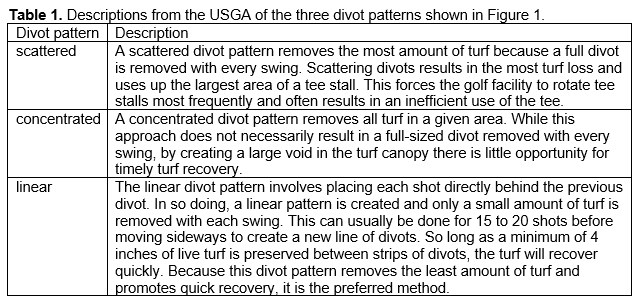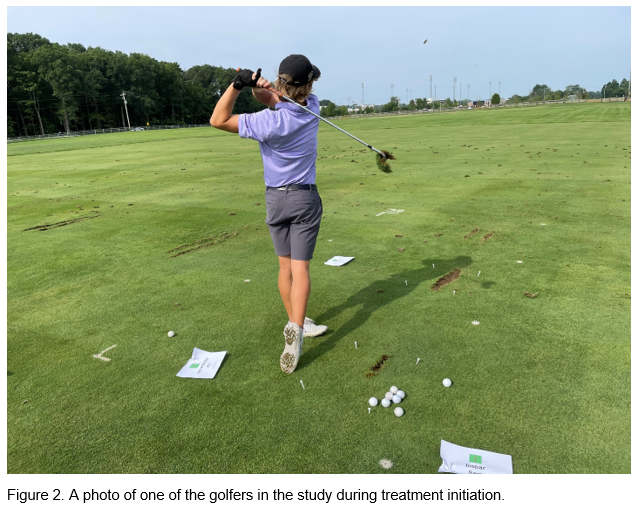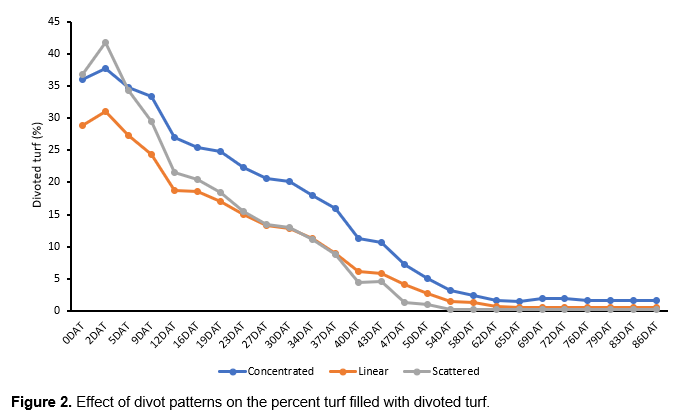Does the Right Divot Pattern Actually Improve Recovery?
Aaron Patton and Naba Amgain
Golfers warm-up and practice on driving range tees by hitting various clubs causing severe damage through the creation of multiple divots. Golf course superintendents shift hitting positions on the range tee to provide a fresh surface for the golfers while simultaneously allowing the recovery of the damaged portion of the tee. Divots can be of different shapes and sizes depending on the club used and the divot pattern used by the golfer. Golf courses commonly post signage related to the preferred divot pattern (Figure 1, Table 1). The linear divot pattern is preferred and recommended by the USGA because it “removes the least amount of turf” and “promotes quick recovery.” However, neither a removal of less turf or a faster recovery has been documented beyond anecdotal accounts. Faster divot recovery is very important for golf courses to use driving range tee space efficiently. To help study this more thoroughly, the USGA funded a study in the summer of 2023 at Purdue University. Our objective was to quantify the impact of three common divot patterns on available tee space, divot mix needs, and divot recovery.

We conducted an experiment at the W.H. Daniel Turfgrass Research and Diagnostic Center in West Lafayette, IN on a ‘Penncross’ creeping bentgrass fairway mown at 0.5”. The site was established in 2012 and received 2 lbs N/1000 sq. ft (applied over three applications annually). The site was also treated with fungicide to ensure 100% green turf to quantify divot injury and recovery using digital image analysis.
Three divot patterns were created by four single digit handicap golfers. Each golfer struck 10 full shots with a sand wedge (54-56 degrees). The treatments were arranged in randomized complete block design with three replications of each divot pattern. In total, there were 39 plots [3 blocks × (4 golfers x 3 divot patterns, plus a nontreated plot)] (Figure 2). Each plot was randomly assigned a golfer and pattern. Golfers were instructed to hit 10 shots from each plot per the prescribed pattern. Each golfer hit 90 total sand wedges (3 reps, 3 patterns, 10 golf balls for each plot) on August 2, 2023 to initiate the experiment.

Divots were filled with sand, and the volume of sand required to fill the divots was recorded. The total area of divots was quantified with digital image analysis and digital images of each plot were collected twice per week to quantify recovery.
The total teeing area made unavailable for other golfers was determined for each divot pattern. This was done by using a rectangle frame around each area of divots, allowing for a 2” border of green grass. The “area made unavailable” was used as a proxy to determine how much tee space would be occupied or created by each pattern.

Initial results: The results showed that a linear divot pattern had the lowest percentage of divoted turf, whereas a scattered pattern had the highest. The scattered divot pattern resulted in less teeing area being available compared to linear and concentrated divot patterns (Table 2). The amount of sand required to fill divots was not significantly different, but the concentrated divot patterns had numerically higher sand requirements compared to scattered and linear divot patterns.

Recovery: In the beginning, scattered divot patterns had a higher area of divoted turf (Figure 2), but this type of divot recovered the fastest (Figure 3). By 54 days after we started the experiment, divots in scattered plots recovered fully, linear divots were recovered 95%, and concentrated divots were recovered 92%.
The recovery rate of individual plots was higher for scattered divot patterns followed by linear and concentrated patterns (data not shown). Scattered divots recovered 50% in 19 days, linear divots recovered 50% in 27 days, 8 days after scattered divots. Concentrated divots recovered 50% in 34 days, which is 15 days later than scattered divots and 7 days slower than the linear divot pattern.
It is evident that the golfers divot pattern impacts the available tee space, divoted turf percent and divot recovery. Although the scattered pattern had a higher area of impact and a higher percentage of divoted turf, this divot type was fastest to recover. This pattern would work well when sufficient driving range tee space is available. Concentrated divots had a lower area of impact and percentage of divoted turf, but required the most time to recover. This type of divot should be avoided. The linear divot pattern appears to be the best divot pattern option as it had a lower area of impact and divoted turf than scattered pattern and a higher recovery rate than concentrated pattern. This pattern would work best when driving range tee space is limited which is likely the case for most golf courses.
We plan on repeating this experiment in 2024 to confirm our preliminary results and learn more about divot recovery. The USGA is also interested in doing this research on bermudagrass tees.


